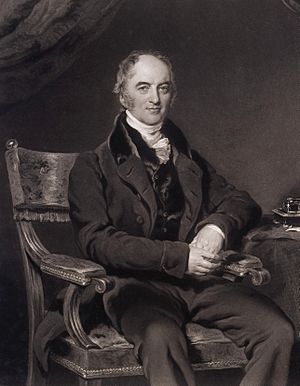John Taylor (mining engineer) facts for kids
Quick facts for kids
John Taylor
|
|
|---|---|
 |
|
| Born | 22 August 1779 Norwich, England
|
| Died | 5 April 1863 (aged 83) London, England
|
| Nationality | English |
| Occupation | Engineer |
| Relatives | John Taylor (father), Susannah Taylor (mother), Philip Taylor (brother), Richard Taylor (brother), Edward Taylor (brother), Sarah Austin (sister), Daniel Pring (brother-in-law) |
John Taylor (born August 22, 1779, in Norwich – died April 5, 1863, in London) was a very important British mining engineer. He helped develop new machines and ways to mine valuable metals like copper. He also played a big part in building canals and railways that helped transport these materials.
Life of John Taylor
John Taylor was the son of John and Susannah Taylor. His brother was Philip Taylor. John Taylor became famous for his work in mining and engineering.
John Taylor's Business Ventures
Many of John Taylor’s business ideas were supported by the Martineau family. They helped him get the money he needed.
The "Cornish Rolls" Crusher
In 1796, when he was just 17, John Taylor created a new machine. It was a mechanical crusher for copper ore at a mine called Wheal Friendship. This mine was near Tavistock, Devon. Over time, this machine got better and was used by many mines. It became known as the "Cornish rolls."
Just two years later, in 1798, John Taylor became the manager of the Wheal Friendship mine. He was only 19 years old! His sons and other family members continued to work with this mine for almost 100 years.
Building the Tavistock Canal
From 1803 to 1817, John Taylor managed the building of the Tavistock Canal. This canal connected the town of Tavistock to Morwellham Quay. At Morwellham Quay, cargo was loaded onto ships on the River Tamar. Canals were like highways for boats, making it easier to move goods.
Chemical Manufacturing and "The Battle of the Gases"
In 1812, Taylor started a chemical factory in Stratford, Essex. This business, also funded by the Martineaus, first aimed to make vitriol (a type of acid). However, the company, Taylor & Martineau, grew and made many different products.
One of Taylor's interests was refining sugar. In 1815, he got a patent for a new way to separate sugar from molasses using pressure. This process also led to the discovery of naphtha, which is a type of oil.
Later in 1815, Taylor got another patent for turning animal oils into gas. This discovery led to a big competition in 1823. It was called "the battle of the gases." This was a fight between companies that made gas lighting from coal and those that made it from oils. However, in the 1820s, John Taylor decided to focus more on mining again.
Leading Cornwall's Mines
In 1819, John Taylor raised £65,000 to reopen the Consolidated Mines in Gwennap, Cornwall. This was a huge amount of money back then! This mine became the most productive in Cornwall. It employed over 3,000 people and produced nearly 450,000 tons of copper ore.
Taylor also worked as a mineral agent for important people like the Duke of Devonshire. He also advised the commissioners of Greenwich Hospital on mining.
Building the Redruth and Chasewater Railway
To help transport the ore from the Consolidated Mines, Taylor built the Redruth and Chasewater Railway in 1824. This railway moved the ore from the mines to the port at Devoran. Railways were a new and efficient way to move heavy materials.
Expanding Copper Mines in Cumbria
In 1824, he also started a major expansion of the copper mines at Coniston in Cumbria. Under his leadership, these mines became "the largest and most profitable copper mines in the north" of England.
In 1836, he installed a new engine at Penrhyn Dû Mines. He also held a lease for these mines starting in 1838.
John Taylor's Intellectual Life
John Taylor was not just a businessman; he was also very involved in the scientific community.
In 1807, he was chosen as a Fellow of the Geological Society. This is a group for people who study rocks and the Earth. He was also their treasurer from 1816 to 1844.
In 1825, he became a Fellow of the Royal Society. This is one of the oldest and most respected scientific groups in the world.
He also helped start the British Association on June 26, 1832. He was the treasurer for this group until September 1861. John Taylor was also one of the founders of University College, London, a famous university. He served as its treasurer for many years.
John Taylor's Writings
John Taylor wrote several important books and articles. He wrote Statements concerning the Profits of Mining in England in 1825. He also edited Records of Mining in 1829. He wrote articles for scientific journals too. He even contributed articles about mining to Rees's Cyclopædia, which was like an early encyclopedia.
John Taylor's Family
In 1805, John Taylor married Ann Pring. Ann was the sister of Daniel Pring. They started their family at Holwell House in Whitchurch, Devon.
In 1829, the famous composer Felix Mendelssohn stayed with the Taylor family. He visited their country home in Wales. While there, Mendelssohn wrote several pieces of music. This included an operetta called Son and Stranger. He wrote it for his parents' silver wedding anniversary. He also composed an organ piece for his sister's wedding. Plus, he wrote three piano pieces as gifts for Taylor's daughters.

